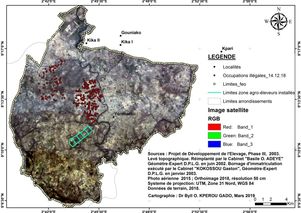Weight-gain and economic performance of Borgu bull calves supplemented with Vitanimal in Benin
DOI:
https://doi.org/10.19182/remvt.36323Keywords
Borgu cattle, calves, meat animals, weight gain, ruminant feeding, feed supplements, BeninAbstract
In order for animals to improve their production potential, especially during the dry season when fodder becomes scarce and of poor quality, feed supplements are increasingly made available to them. The effect of Vitanimal, an industrially made feed, mixture of husks and cotton cake, was tested on 15 Borgu bull calves at the Okpara Breeding Farm in order to measure its impact on their growth. The cattle were divided into three groups of five bulls each with an average weight of 103 kg ± 22 kg. They were fed the test feed in equal parts before and after grazing. Group 1 was the unsupplemented control, groups 2 and 3 received 1 and 2 kg per day of Vitanimal feed supplementation, respectively. Refusals were quantified. The animals were also given water and salt blocks ad libitum. Calves were weighed every other week for 90 days. Analyses highlighted a significant difference (p < 0.05) between groups 2 and 3 in the tested feed intake. The results showed a significant effect of Vitanimal on the growth of the calves. The average daily gains in the control group, in group 2 and in group 3 were 386 ± 147 g, 652 ± 115 g and 927 ± 160 g, respectively. The impact of Vitanimal depended thus on the amount fed, and the group 3 diet was more cost-effective, with a 238% return on investment, than group 2 (232%).
Downloads
References
Archimède H., Bastianelli D., Boval M., Tran G., Sauvant D., 2011. Ressources tropicales : disponibilité et valeur alimentaire. Prod. Anim., 24 (1): 23-40 DOI: https://doi.org/10.20870/productions-animales.2011.24.1.3235
Boudet G., 1991. Manuel sur les pâturages tropicaux et les cultures fourragères. La documentation française, Paris, France, 266 p.
COUNTRYSTAT/Bénin, 2015. Base de données statistiques. www.fao.org/economic/ess/countrystat/en/ (consulté 18 jan. 2018)
DE, 2006. Afrique de l’Ouest : mobilisation des investissements pour le développement rural et agricole dans la zone CEDEAO, Direction de l’élevage. FAO, Rome, Italie, 53 p.
DE, 2016. Rapport annuel 2015. Direction de l’Elevage, République du Bénin, 106 p.
De Haan L.J., 1997. Agriculteurs et éleveurs au nord Bénin : écologie et genres de vie. Karthala, Paris, France, 217 p.
Dehoux J. P., Hounsou-Vê G., 1993. Productivité de la race bovine Borgou selon les systèmes d’élevage traditionnels au Nord-Est du Bénin. Rev. Mond. Zootech., 36-48
Doko S.A., 2014. Cours de Zootechnie générale. Faculté d’Agronomie, Université de Parakou, Bénin, 30 p.
Dugué P., Jouve P., 2003. Organisation spatiale et gestion des ressources et des territoires ruraux. Actes du colloque international, 25-27 février 2003, Montpellier, France. Karthala, 217 p.
Guerin H., Lecomte P., Lhoste P., Meyer C., 2002. Généralités sur les ruminants. In: Mémento de l’Agronome. CIRAD, Montpellier, France, 1313-1324
Houndonougbo M.F., Chrysostome C.A.A.M., Babatoundé S., Lokossou H.R., Agbota B., 2012. Fourrages de Moringa oleifera et de Gliricidia sepium utilisés comme compléments alimentaires efficaces pour nourrir des veaux girolando au Bénin. Ann. Sci. Agron., 16 (1): 35-49
Kiéma A., Nianogo A.J., Ouedraogo T., Somda J., 2008. Use of local feed resources in the farmers ram fatting scheme: technical and economic performance. Cah. Agric., 17: 24-27
Magnani S., 2020. Améliorer l’accès des éleveurs à une alimentation du bétail de qualité pour augmenter la production laitière dans les Pays sahéliens d’Afrique de l’Ouest. Note thématique, 20 p.
Montcho M., Babatoundé S., Aboh B. A., Bahini M. J. D., Chrysostome A. A. M. C., Mensah G. A., 2016. Performances zoo-économiques en milieu réel des ovins djallonke complémentés par les blocs multi nutritionnels au Bénin. J. Rech. Sci. Univ. Lomé (Togo), Sér B, 18 (4): 9-22
Sansoucy R., 1991. Problèmes généraux de l’utilisation des sous-produits agro-industriels en alimentation animale dans la région méditerranéenne. In: Tisserand J-L., Fourrages et sous-produits méditerranéens-Zaragoza : CIHEAM. (ed. Alibés X.). Options Méditer. Sér. A, 16: 75-79
Tiémoko Y., Bouchel D., Kouao Brou J., 1990. Growth incidence upon Baoule steers of different levels of cotton seed and molasses supplementation of a fresh and hay diet (Panicum maximum) during their postweaning period. Rev. Elev. Med. Vet. Pays Trop., 43 (4): 529-534 DOI: https://doi.org/10.19182/remvt.8785
Zampaligré N., 2012. The role of ligneous vegetation for livestock nutrition in the sub-Sahelian and Sudanian zones of West Africa: Potential effects of climate change. PhD thesis, University of Kassel, Germany, 102 p.

Downloads
-
Abstract1739
-
pdf (Français)440
Published
How to Cite
License
© L.S.Guidimê et al., hosted by CIRAD 2021

This work is licensed under a Creative Commons Attribution 4.0 International License.







